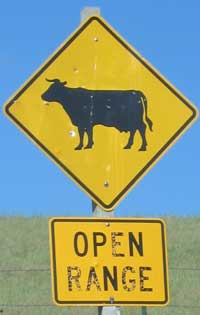 |
Visual Treats During My Commute
from the RV Campground |
Each day I must descend 3,500 feet into the valley then climb again late that afternoon. Once I leave Interstate 5, I'm on a two lane mountain road with many 20 mph curves and switchbacks. I'm scanning the sides of the road constantly for deer because they are ever present and will dart in front of me in a second. I get to see things you would not normally see on a commute.
April 28, 2005: The fields as I'm climbing back to the resort are covered with a purple flower. |
 |
|
 |
 |
I haven't yet identified the flower. My flower ID book has failed me and I've not found anyone at the lake who knows the name of this flower. If you happen to know the name, let me know so I can put the information here. |
|
  |
May 19, 2005: There is a hat on that post I thought to myself as I drove by only about 20 feet from the post. My second thought was that someone had put one of those fake plastic owls on the post to scare away .... what? What did they want to scare from that field. Those plastic owls are usually on roof tops to keep birds out of water coolers and air conditioner equipment. Turn around and take a second look was my third thought. Get you camera ready was my fourth thought.
Nope, it's not moving, it's a very strange looking hat. Still not moving. |
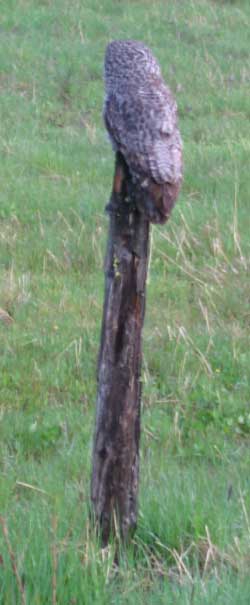 |
|
|
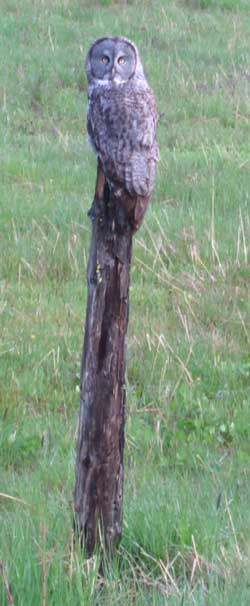 |
Focus your camera! Hold still! Stop shaking. Man! This is a BIG bird! Stop shaking. Put on the telephoto (OH, PLEASE - don't fly away). It only wants to LOOK at the field. Whistle! Nothing ... it's a hat. Whistle again. OH, my gosh ... it's an owl! I've never seen an owl or a bird this size before. It must be 18" tall at least. Whistle, take another picture. The owl is looking annoyed like I'm disturbing his dinner or in this case, dinner-hunt. Finally, the owl is annoyed enough, it flies to the middle of the field.
I check my bird book when I get back to the trailer. It's a Great Gray Owl. Found mostly in Canada and along the mountains of the west coast. I feel very privileged to have seen it today. when I get back to the trailer. It's a Great Gray Owl. Found mostly in Canada and along the mountains of the west coast. I feel very privileged to have seen it today. |
|
|
Each morning I drive off my 4,500 foot perch in the Cascades looking across the valley at Mt. Ashland Ski Area. Some mornings are clear and the view is spectacular while other mornings are "partly cloudy" so the mountain becomes mysterious. I know this view will change as the season turns to summer. Look at a late May morning view of this wonderful mountain. |
 |
|


|
June 25, 2005: I'll bet you don't see one of these on your commute to work. On may trip down the mountain I pass a small farm with many exotic animals in the yard. Occasionally the Peacock will be standing in the road or on a nearby fence post as it is today. I whistled and called but could not interest this handsome male to show me his pretty feathers. I guess I need to sound or look like a female Peacock to get him to show off. |
 |
|
|
|
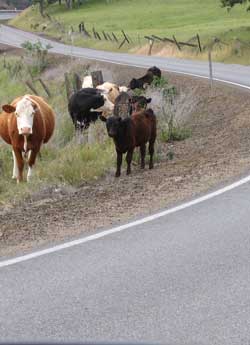 |
OPEN RANGE ... July, 2005
There are cows in the road. I see this many days of my commute. It would be a real mess to hit one of these. They seem happy and there is plenty to eat. |
| Cows on both sides of the road, calves too. |
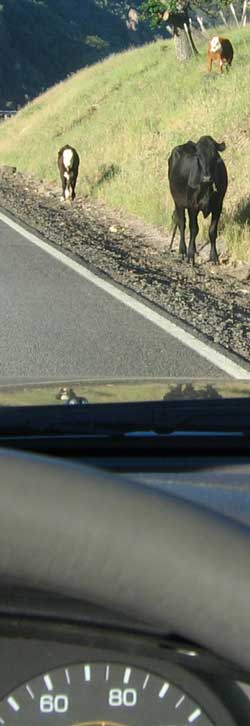 |
| |
|
This is open range country. Sometimes there are fences to divide pastures but no fences parallel to the road. So cows are free to graze on the side of the road. |
| |
This needs a cattle guard to keep the cows in the proper pasture. |
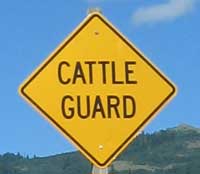 |
| |
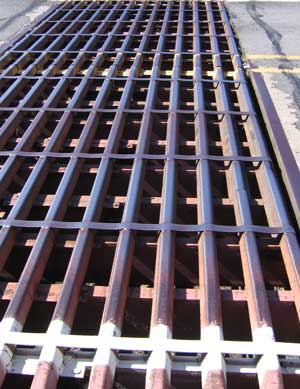 |
This is what a cattle guard looks like. Cattle can't walk on these rails. Cars have no problem with these but if you are on a motorcycle or bicycle you must hit these at a 90° angle, hence the warning sign. |
|
| |
Here is another cattle guard. It's painted on the road. I don't understand this one. Do you think a cow is really fooled by these painted lines?
I help put these roaming cows back into their pasture. |
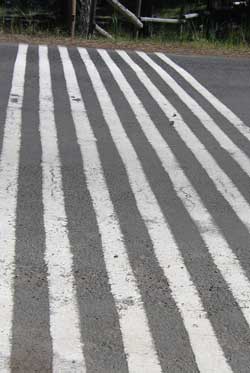 |
 |
|
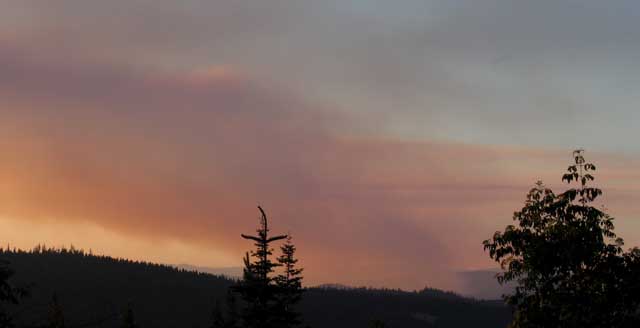 |
| July 26, 2005: This is not something you want to see while driving home to your RV resort in the mountains. This is a forest fire about 15 miles north of the Howard Prairie Lake Resort. The smoke is being blown to the north and to the east so that will not affect the resort now but can change at any moment. Forest fires can travel fast especially when it has been hot and dry for the last month. I also noticed that a large four engine fire bomber was already working this fire and I'm hoping that we already have some fire-fighting helicopters working this fire since we are the home to Erickson Air-Crane Fire-Fighting helicopters. |
|
| August Note: The fire I spotted on the commute home in July resulted in 6,500 acres burned and took over a week to contain. It was started by a roll-over accident on Highway 140. The sparks between the metal of the rolling car against the asphalt started the dry grass on fire. It took hundreds of fire fighters, air tankers, and helicopters to contain the fire. No firefighters were injured and the vehicle occupants had only minor injuries. |
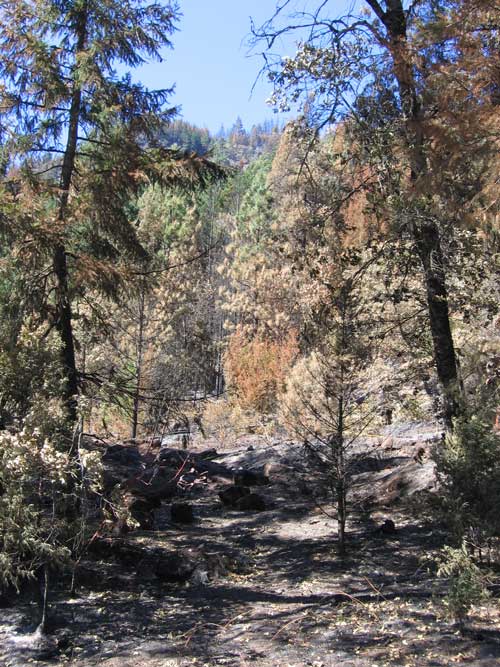 |
|
| |
| We talked about the cows in the road once before but they seem to have multiplied. I find them on the road almost every commute day. |
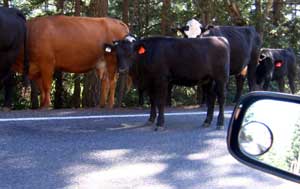 |
|
|
| |
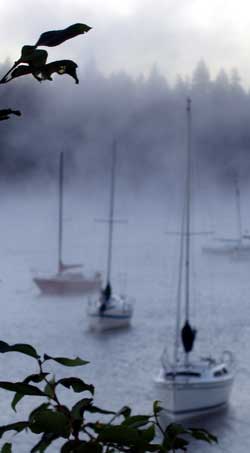 |
The early morning mist around Pepper is showing that the water temperature is warmer than the air temperature. I'm beginning to see this every morning with the sun coming up only a few minutes before I must leave for my commute. In this photo, the sun will come over the horizon in a few minutes. |
| September 9, 2005: I haven't seen this since last May during my commute. The Ashland School district sends a bus up the mountain where it turns around at the mail boxes (last photo on the commute page). Then the bus picks up school children on the return trip to Ashland. Occasionally I get behind the bus on my descent but the bus driver always knows I'm there and pulls over to let me by otherwise I'd be stopping with the bus every other driveway. |
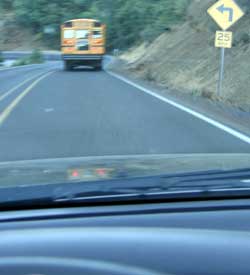 |
|
| |
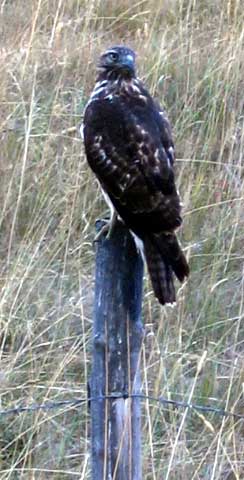 |
What do you think? This bird was sitting and posing for me this week during my commute. I've looked in two bird books and all I could come up with was an immature Bald Eagle. We do have several mature Bald Eagles in the area so I suppose it is possible. If you think differently, send me an email and I'll make a correction. This was a very large bird, probably 18" from head to tail feathers and when it left, had a very large wing span. |
|
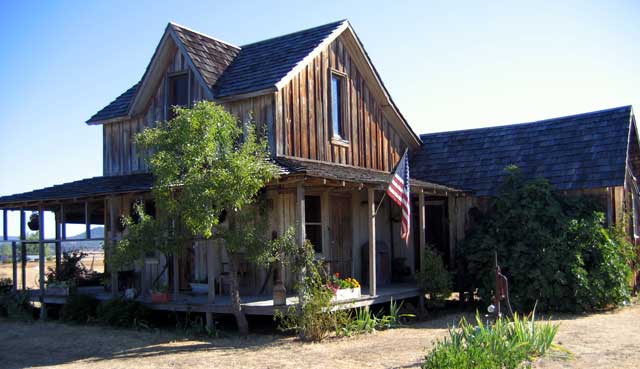 |
| This is probably the most photographed house in southern Oregon. This morning I needed to make deliveries as part of my job so I drove past the Marvin Sylvester Wood home which was built in 1870. It has been partially restored so is in better condition than a few years ago. It has been used as a joke on post cards in the recent past as an "Oregon Fixer-Upper". Because of it's location, condition and age, it is photographed by nearly everyone who drives highway 62 toward Crater Lake from Medford. Even though this house is 135 years old, I had relatives who traveled the Oregon Trail in 1847 so there must be older homes somewhere in Oregon. For comparison of history with other areas, Oregon became a state on February 14, 1859. This house was built eleven years after Oregon became a state. Enough reason for many in southern Oregon to call it "historic". |
|
| |
This is what fall looks like in the foothills of the Cascades on my commute to and from Medford. Compare this photo with the spring photo I took last April. When you have little or no rain for 3+ months, this is what the hills look like. This is typical southern Oregon weather, generally wet in the winter and spring but very dry during the summer months. |
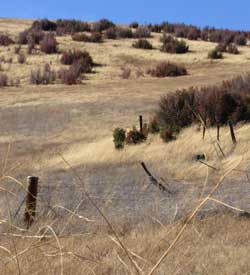 |
|
|
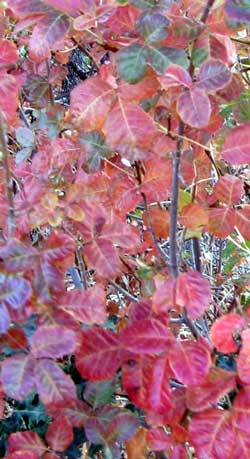 |
September 26, 2005: Beautiful fall colors are showing up on my commute route as I drive down the mountain. The hills are beginning to turn into shades of red, orange and yellow. These are brightly color bushes and they can be found at about the 2,000 foot elevation and lower. This bush does not exist at the resort although we will have plenty of fall colors soon. Learn more here. |
| Here you can see these bright bushes stretched all along my commute route. The road is at the top of the photo. If you are not from the west, you may not recognize this bush. It is Poison Oak. When I first moved to southern Oregon, I bought a 38 acre tree farm however the biggest crop on the place was Poison Oak. I first imagined all sorts of methods to market this as a crop but later decided the liability was too great. These bushes will soon lose all leaves but their affect on someone who is allergic to them will still be as great. |
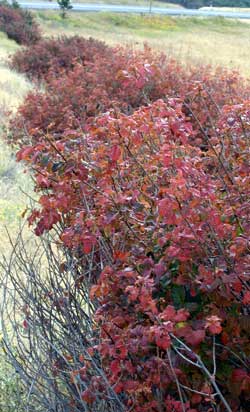 |
|
| |
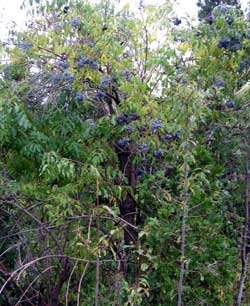 |
September 27, 2005: Higher into the mountains at about the 5,000 foot level you will see trees with clusters of blue berries along side my commute route. These are Blue Elderberry trees. I've seen many people in the last few days stopped along the road picking the blue berries. This can be a real task since these trees can grow to 25 feet. The Field Guide to North American Trees says: says: |
| |
"The sweetish, edible berries are used in preserves and pies. Lewis and Clark first reported Blue Elder as an "alder" with "pale, sky blue" berries. Whistles can be made by removing the pith from cut twigs; California Indians made flutes in a similar fashion. A remedy for fever has been concocted from the bark. Blue Elder is planted as an ornamental for numerous whitish flowers and bluish fruits." For more information click here. |
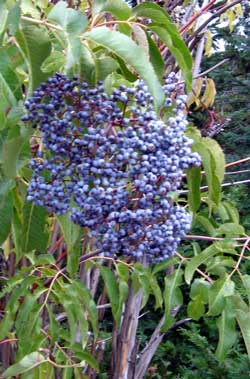 |
|
 |
| September 30, 2005: No, this wasn't my commute today it was one week ago today. Today I expect clouds but still warm, low 70's. Tomorrow, rain is projected ... we'll see if we get more of the "white stuff". |
|
| Along my commute route on Dead Indian Memorial Road from Ashland to the Howard Prairie Lake Resort are several green boxes hanging from tree branches. These boxes are marked "Insect Trap" and are placed by the Oregon State Department of Agriculture. Depending upon the state you live in, you may have heard of the agricultural damage that can be caused by the Gypsy Moth. Of course, the state of Oregon would like to keep this insect pest out of the state. As it turns out, the folks in RV's play a part in the transportation of this pest from one area of the country to another. Several Gypsy Moths have been found in these traps, especially near RV parks. Perhaps we can help stop the spread of these pests. |
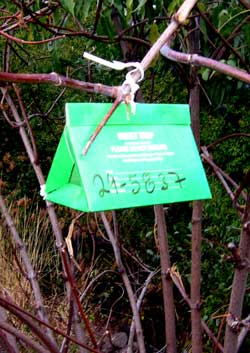 |
|
| |
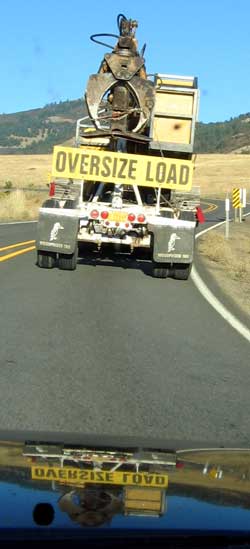 |
October 13, 2005: This has happened to me only once so far this year. What? A 5 MPH commute up my mountain to the resort. This is a very heavy machine which picks up whole logs and loads them onto log trucks. It is wide and long and can only proceed at a very slow speed up this steep hill. Note the double yellow line. The double yellow goes for 17 miles up the mountain and there are no turn-outs big enough for this large machine. So must I admit to crossing the double yellow at a safe spot?
Have you learned from my posting that so-far, this is all worth it to me? My poor old Toyota has 232,000 miles on it so I'm beginning to think I may have to replace it soon. |
|
| |
October 19, 2005: Now my commute down the mountain is before the sun is over the horizon. This morning I was driving into a full moon toward Ashland. The brown, dry hills are just barely visible in the moonlight and early dawn rays. The school bus passed by while I was taking my photographs so all the school children are boarding the bus in the dark and watching the Ashland lights just as I am. Fortunately I still have an hour of daylight when I get home from work but soon I will be leaving in the dark and arriving home in the dark. Of course this is nothing new to those who live farther north but it always makes the days seem longer to me and I begin to wish for vacation time. |
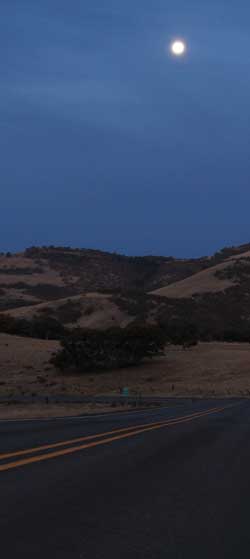 |
| |
|
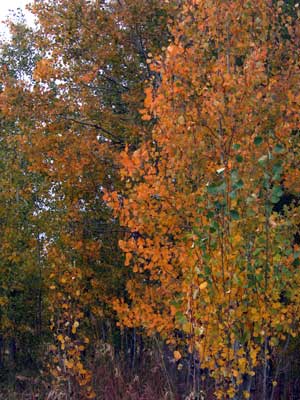 |
October 21, 2005: The Aspens are the first to begin changing to their fall colors at the higher elevations. As I drive from the 5000 foot level to the 1800 foot level in the valley I'm able to watch the color changes from the browns at the top to orange and red, then back to yellow and green as I approach the valley. It's like driving through different climate zones or seasons all in a period of 30 minutes. That's my driving time from the top to the bottom, 30 minutes.
Yesterday, I added an RSS Feed to my home page. Do you know what that is. I've not used them but they seem to be very popular especially for news sites and for pages that are changing every day. |
|
|
| You've seen this bush before. Here is what it looked like the last time you saw it. This time this bush has no leaves but if you are allergic to Poison Oak, it will not matter if the bush has leaves or not. That is one of the things about Poison Oak that can make it such a problem. The plant will change with the seasons. Now it has no leaves, the last time you saw it, red and orange leaves, during the summer, green leaves and of course, in the spring bright great buds. This plant will also take different shapes. Here it is a bush, but you can also see it as a vine growing around and up a tree. No matter what shape, leaves or no leaves, if you are allergic to Poison Oak ... it will get you. |
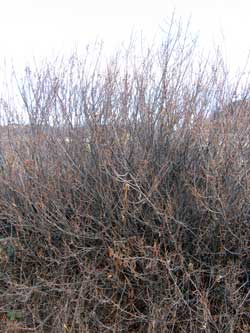 |
|





when I get back to the trailer. It's a Great Gray Owl. Found mostly in Canada and along the mountains of the west coast. I feel very privileged to have seen it today.





